Perovskite solar cell testing in underwater environments shows surprising efficiency results
Researchers in Italy have tested how perovskite solar cells could perform underwater and have found that, at very shallow depths, they may even achieve a higher power conversion efficiencies compared to reference devices operating under out-of-water conditions.

Researchers in Italy have tested how perovskite solar cells could perform underwater and have found that, at very shallow depths, they may even achieve a higher power conversion efficiencies compared to reference devices operating under out-of-water conditions.
A research team in Italy has tested the performance of semitransparent wide-bandgap perovskite solar cells in underwater (UW) environments and has found that, at a 0.5–1 cm depth, the devices achieve a higher power conversion efficiency thanks to the refraction index of water.
“The novelty of our work lies in a completely in-house process encompassing perovskite solar cell fabrication, encapsulation testing via lead-leakage tests and the actual submersion of perovskite solar cells in water,” the research's corresponding author, Jessica Barrichello, told pv magazine. “Perovskites are traditionally considered unsuitable for humid environments, and for the increasingly human-occupied underwater realm, which is seeing the development of activities such as wine aging and plant cultivation.”
In the paper “Beneath the Surface: Investigating Perovskite Solar Cells Under Water,” published in Energy & Environmental Materials, the researchers explained that UW environments would require photo-absorbers with a wide bandgap of 2–2.3 eV, such as those used in perovskite PV devices, while most commercially available silicon absorbers have a narrow bandgap of 1.11 eV. They also stressed, however, that perovskites are subject to fast degradation of the bulk film when hit by moisture.
To solve this issue, the academics used a “robust” encapsulation procedure to build a solar cell based on an absorber made with a perovskite material known as FaPbBr3, which has an energy bandgap of 2.3 eV.
The scientists built the 1 cm2 cell with a substrate made of fluorine-doped tin oxide (FTO), an electron transport layer (ETL) relying on tin oxide (SnO2), the FaPbBr3 absorber, a hole transport layer (HTL) based on poly(triarylamine) (PTAA), and an indium tin oxide (ITO) top electrode. The latter was intended to enable the harvest of light reflected from the surrounding water.
The cell was encapsulated with adhesive polyisobutylene (PIB) material, which is commonly used for perovskite solar cells and is an industrially compatible solution that does not require solvents in a strain-free lamination process. “The PIB encapsulant increases the transmittance value from 600 to 800 nm without affecting the blue-green region (400–600 nm) where wide-bandgap perovskites can effectively absorb the light,” the researchers emphasized.
Under standard illumination conditions, the solar cells achieved an efficiency of around 6.79%.
The team tested the performance of the devices immersing them in a water tank, the first time for 24 h and the second time for 120 h. The cells were placed at three depths: 0.5 cm below the water surface, 3 cm below, and 6 cm below. At 0.5 cm, the devices showed an increase in efficiency of up to 8% compared to the initial out-of-water conditions, which the scientists attributed to higher short-circuit current values.
“The increase in the current, and consequently of the efficiency is related to anti-reflective coating effect of water on top of the solar cell,” they further explained, noting that lower temperature in water may have contributed to the cell's improved performance. “However, a more pronounced decrease is observed with the increasing water depth.”
Based on other experimental and simulation results, the scientists concluded their work by saying that perovskite-based devices could be potentially used in the future to power low-power Internet of Underwater Things (IoUT) devices at a depth of up to 10 m.
The research team comprised scientists from Italy's CNR-ISM Institute of Structure of Matter, CHOSE (Centre for Hybrid and Organic Solar Energy) Tor Vergata University, and Italy-based two-dimensional materials provider BeDimensional SpA.
The performance of underwater solar cells was investigated in 2020 by scientists from the Birla Institute of Technology and Science and the Indian Institute of Technology Kanpur and Defence Materials. According to their findings, submerged cells benefit from lower temperatures and an ideal environment for cleaning. “Although there are challenges and limitations, the results obtained show that there is an enormous potential for solar PV technology in underwater monitoring sensors or devices, and various other commercial and defense applications with modern-day power electronics,” the researchers stated at the time.
In 2022, researchers in China used commercially available solar cells to create an underwater-optimized lens-free system for high-speed optical detection and found that the PV devices enabled a much larger detection area than commonly used photodiodes.
What's Your Reaction?
























































